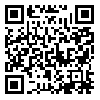BibTeX | RIS | EndNote | Medlars | ProCite | Reference Manager | RefWorks
Send citation to:
URL: http://jha.iums.ac.ir/article-1-227-en.html
The research was intended to determine the rate of coding accuracy in the training hospitals of Shiraz University of Medical Sciences and Health Treatment Services in 1995 (1374), and it was performed through a descriptive-analytic method. In the research, 400 medical records were selected based on stratified sampling method from among records of the patients having been discharged from hospitalization wards in 1995 and were coded in a blind method by the researcher. Using a questionnaire and two checklists, designed by the researcher, data collection was performed through interviews with 1995 coding officials, as well as review of sample records and indexes of disease and procedure adopted. Results of the research indicate that the coding rate is 01 for primary diagnosis and 96'/, for principal diagnosis. The rate of coding accuracy of the principal diagnosis is 81.251, and 92.951 for other diagnoses, 95.22/ for principal procedure, and 93.55/ for other procedures. from total coded cases, 88.46/ have been coded correctly, 8.20/ incorrectly, and 3.34/ incompletely and 52.751 of the errors pertain to the main figures of the codes. Also, the research results indicate, that there is a meaningful , connection between the age of coding staff and coding accuracy. Examination of the rate of the registration and correctness of characteristics in the indexes of disease and procedure indicate that these rates for some characteristics are less than one hundred percent and that the lowest registration rate in the index of disease pertaines to the age characteristic (73.47/,) and in the index of procedure petaines to the duration of hospitalization characteristic (99.06/). The lowest rate of correctness in both disease and procedure The research was intended to determine the rate of coding accuracy in the training hospitals of Shiraz University of Medical Sciences and Health Treatment Services in 1995 (1374), and it was performed through a descriptive-analytic method. In the research, 400 medical records were selected based on stratified sampling method from among records of the patients having been discharged from hospitalization wards in 1995 and were coded in a blind method by the researcher. Using a questionnaire and two checklists, designed by the researcher, data collection was performed through interviews with 1995 coding officials, as well as review of sample records and indexes of disease and procedure adopted. Results of the research indicate that the coding rate is 01. for primary diagnosis and 961. for principal diagnosis. The rate of coding accuracy of the principal diagnosis is 81.251., and 92.951. for other diagnoses, 95.221. for principal procedure, and 93.551. for other procedures. from total coded cases, 88.461. have been coded correctly, 8.201. incorrectly, and 3.341. incompletely and 52.751. of the errors pertain to the main figures of the codes. Also, the research results indicate, that there is a meaningful . connection between the age of coding staff and coding accuracy. Examination of the rate of the registration and correctness of characteristics in the indexes of disease and procedure indicate that these rates for some characteristics are less than one hundred percent and that the lowest registration rate in the index of disease pertaines to the age characteristic (73.47/.) and in the index of procedure petaines to the duration of hospitalization characteristic (99.06/.). The lowest rate of correctness in both disease and procedure indexes pertains to the lenght of hospitalization characteristics (94.9 and 91.47 respectively), and correctness of other characteristics in the disease index is over 95%
The results indicate ineflicienciey such as failure to code factors effective. on health status and non-surgical procedures, failure to comply with regulation of the coding books, failure to refer to the classification numerical lists for coding all diagnosis and procedures, coding without removal of inperfections from records, failure to examine registration and correctness of necessary codes, as well as, registration and accuracy of characteristics in the indexes of disease, and procedure in number of coding unit, lack of written policy, failure to note "Primary diagnosis" in the forms of "Admission and discharge summary" and "discharge summary" and not benefiting all medical record sheets for coding. The researcher believes, the foregoing factors could be considered among those which have left negative effect on the rate of coding and its accuracy as well as on the rate of registration and accuracy of characteristics of the disease and procedure indexes.
Received: 2008/11/12 | Published: 2000/01/15
| Rights and permissions | |
 |
This work is licensed under a Creative Commons Attribution-NonCommercial 4.0 International License. |





